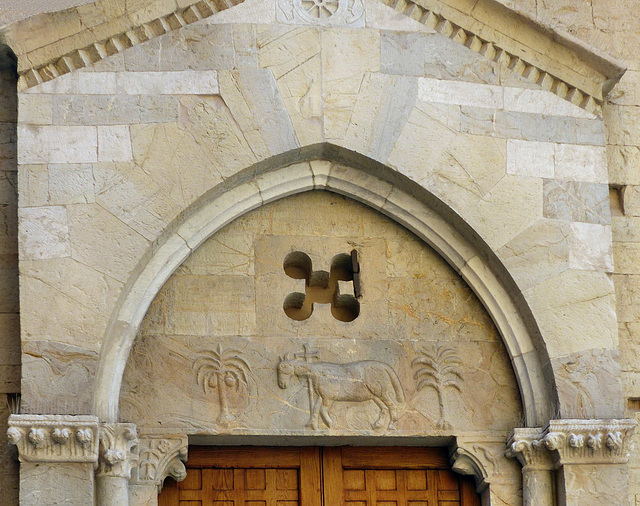Avord - Saint-Hugues
Wissembourg - Saint-Ulrich d'Altenstadt
Bravães - Igreja de São Salvador
Rates - São Pedro de Rates
La Rochefoucauld - Église d’Olérat
Zweinitz - St. Ägidius
Tauriac - Saint-Etienne
Bardone - Santa Maria Assunta
Ravenna - San Vitale
Assisi - Cattedrale di San Rufino
Assisi - Cattedrale di San Rufino
Rivolta d’Adda - Maria Assunta e San Sigismondo
Varaize - Saint-Germain
Varaize - Saint-Germain
Alleaume - Notre-Dame
Saint-Junien - Saint-Junien
Fenioux - Notre-Dame de l’Assomption
Fenioux - Notre-Dame de l’Assomption
Fontaines-d'Ozillac - Saint-Martin
Tauriac - Saint-Etienne
Location
See also...
Keywords
Authorizations, license
-
Visible by: Everyone -
All rights reserved
-
70 visits
Sanremo - Concattedrale di San Siro


Sanremo has Roman origins, it prospered in the Middle Age, when the population moved from the coast to high grounds. The town (named
"La Pigna" was walled for protection Saracen raids.
It became a free town in the 15th century. In 1753 it rose against Genoese hegemonical attempts. But Genoa built the fortress of Santa Tecla, situated the port. The fortress still exists. It was used as a prison until 2002. It is now being transformed into a museum.
In 1814, Sanremo was annexed to the Kingdom of Sardinia. From the middle of the 18th century, the town grew rapidly, in part due to the development of tourism, which saw the first grand hotels built and the town extended along the coast. Similar to nearby Nice the nobility holidayed here. "Sissi", Empress of Austria, loved Sanremo. Empress Maria Alexandrovna of Russia and Emperor Nicholas II of Russia spent a winter here. Swedish chemist Alfred Nobel made Sanremo his permanent home.
-
A church existed here already in the 9th century. The church of today was built by Comacini masters in the early twelfth century. From 1619 on the church got modified and finally, the Romanesque structure was transformed into Baroque in 1668. In 1745 a bombing carried out by an English naval formation caused the collapse of part of the roof and facade. After the revolt against the Republic of Genoa in 1753, the bell tower got demolished for punishment. It was then rebuilt in Baroque style
In 1901 restoration works were started on the Romanesque aspect. These works were officially completed in 1948.
An "Agnus Dei" between two date palms. Date palms were not common in Northern Italy.
"La Pigna" was walled for protection Saracen raids.
It became a free town in the 15th century. In 1753 it rose against Genoese hegemonical attempts. But Genoa built the fortress of Santa Tecla, situated the port. The fortress still exists. It was used as a prison until 2002. It is now being transformed into a museum.
In 1814, Sanremo was annexed to the Kingdom of Sardinia. From the middle of the 18th century, the town grew rapidly, in part due to the development of tourism, which saw the first grand hotels built and the town extended along the coast. Similar to nearby Nice the nobility holidayed here. "Sissi", Empress of Austria, loved Sanremo. Empress Maria Alexandrovna of Russia and Emperor Nicholas II of Russia spent a winter here. Swedish chemist Alfred Nobel made Sanremo his permanent home.
-
A church existed here already in the 9th century. The church of today was built by Comacini masters in the early twelfth century. From 1619 on the church got modified and finally, the Romanesque structure was transformed into Baroque in 1668. In 1745 a bombing carried out by an English naval formation caused the collapse of part of the roof and facade. After the revolt against the Republic of Genoa in 1753, the bell tower got demolished for punishment. It was then rebuilt in Baroque style
In 1901 restoration works were started on the Romanesque aspect. These works were officially completed in 1948.
An "Agnus Dei" between two date palms. Date palms were not common in Northern Italy.
- Keyboard shortcuts:
Jump to top
RSS feed- Latest comments - Subscribe to the comment feeds of this photo
- ipernity © 2007-2024
- Help & Contact
|
Club news
|
About ipernity
|
History |
ipernity Club & Prices |
Guide of good conduct
Donate | Group guidelines | Privacy policy | Terms of use | Statutes | In memoria -
Facebook
Twitter

Sign-in to write a comment.